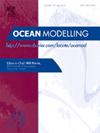海岸工程中一维波浪传播的预训练物理信息神经网络
IF 2.9
3区 地球科学
Q2 METEOROLOGY & ATMOSPHERIC SCIENCES
引用次数: 0
摘要
由于非线性浅水动力学和色散效应的相互作用,模拟波浪在可变海岸地形上的传播仍然具有挑战性。在这里,我们引入了一个预训练的物理信息神经网络(PT - PINN)框架,该框架将物理指导的预训练阶段与严格的交叉验证相结合,以解决Saint - Venant和Boussinesq方程。在预训练期间,网络生成一个物理信息的初始近似,构建辅助监督数据,并产生优化的参数种子,所有这些都加速和稳定随后的正式训练。对预训练衍生的数据集进行交叉验证,然后指导超参数选择,确保物理驱动和数据驱动的损失成分之间的有效平衡。我们在四个基准情景中演示了PT - PINN方法:(1)湿域的溃坝流,(2)倾斜斜坡上的非溃坝波传播,(3)倾斜明渠中的周期性潮汐波,以及(4)淹没防波堤上的浅滩波。在每种情况下,PT - pin都忠实地捕获了体波演化和精细尺度色散细节。对分析和有限差分解决方案的比较研究表明,PT - pin匹配它们的精度,同时在代表高频微尺度特征方面提供增强的稳定性。这些结果强调了预先训练的物理信息网络作为复杂水深环境中海岸波浪建模的多功能和强大工具的前景。本文章由计算机程序翻译,如有差异,请以英文原文为准。
Pre-trained physics-informed neural networks for one-dimensional wave propagation in coastal engineering
Modeling wave propagation over variable coastal topographies remains challenging due to the interplay of nonlinear shallow‑water dynamics and dispersive effects. Here, we introduce a Pre‑Trained Physics‑Informed Neural Network (PT‑PINN) framework that couples a physics‑guided pre‑training phase with rigorous cross‑validation to solve the Saint‑Venant and Boussinesq equations. During pre‑training, the network generates a physics‑informed initial approximation, constructs auxiliary supervised data, and yields optimized parameter seeds, all of which accelerate and stabilize subsequent formal training. Cross‑validation on the pre‑training–derived dataset then guides hyperparameter selection, ensuring an effective balance between physics‑driven and data‑driven loss components.
We demonstrate the PT‑PINN approach across four benchmark scenarios: (1) dam‑break flow in a wet domain, (2) non‑breaking wave propagation on inclined slopes, (3) periodic tidal waves in an inclined open channel, and (4) shoaling waves over a submerged breakwater. In each case, PT‑PINNs faithfully capture both bulk wave evolution and fine‑scale dispersive details. Comparative studies against analytical and finite‑difference solutions reveal that PT‑PINNs match their accuracy while offering enhanced stability in representing high‑frequency microscale features. These results underscore the promise of pre‑trained, physics‑informed networks as a versatile and robust tool for coastal wave modeling in complex bathymetric settings.
求助全文
通过发布文献求助,成功后即可免费获取论文全文。
去求助
来源期刊

Ocean Modelling
地学-海洋学
CiteScore
5.50
自引率
9.40%
发文量
86
审稿时长
19.6 weeks
期刊介绍:
The main objective of Ocean Modelling is to provide rapid communication between those interested in ocean modelling, whether through direct observation, or through analytical, numerical or laboratory models, and including interactions between physical and biogeochemical or biological phenomena. Because of the intimate links between ocean and atmosphere, involvement of scientists interested in influences of either medium on the other is welcome. The journal has a wide scope and includes ocean-atmosphere interaction in various forms as well as pure ocean results. In addition to primary peer-reviewed papers, the journal provides review papers, preliminary communications, and discussions.
 求助内容:
求助内容: 应助结果提醒方式:
应助结果提醒方式:


